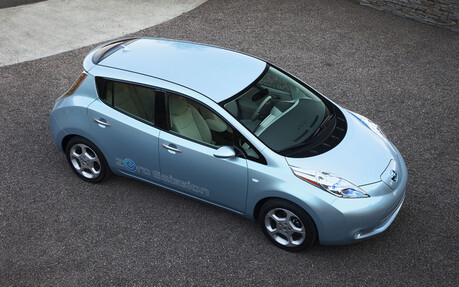2010 Nissan Leaf: The future is electric
Los Angeles, California. - It’s a sign of the times. Automobile manufacturers are leaving the racetrack and heading full speed into the race for environmentally friendly technologies. They know all too well that the first to sell zero-emission vehicles will be graciously rewarded by the public, which now seems ready to tackle global warming and get behind the wheel of more technologically advanced transportation. Ten years ago, General Motors launched the EV-1, an electric vehicle designed for everyday driving, but it failed to meet sales objectives and was subsequently pulled off the market. With that false start behind us, Nissan is now betting that drivers are ready for the Leaf, which will be launched in the U.S., Europe and Asia in 2010.
At the kick-off of the Leaf’s promotional in Los Angeles, a long-wheelbase Nissan Versa outfitted with the Leaf’s electric engine was available for testing on a short circuit set up in the Dodgers Stadium parking area. My first impression of this car was that it was anything but amateur. On the contrary, it was very well accomplished and capable of some honest starting accelerations thanks to its 206 lbs-ft of torque, which is significantly more than a Versa with a conventional engine. Like the Leaf, this prototype was equipped with an energy-regenerating brake system that recharges the battery every time you accelerate – the same kind of technology used for hybrid engines. This system works so subtly you could almost call it imperceptible, which is certainly not the case in hybrids. In terms of handling, this prototype was very comparable to a Versa with a conventional motor. At least, that’s what it was like on the short circuit; its handling in normal conditions remains to be seen.
Nissan is proving to be both ambitious and visionary with this project, as it consists not only in building an electric vehicle, but also in creating the batteries it will run on. The Oppama factory in Japan was chosen to produce the Leaf, a five-seat sedan built on an all-new platform that was presented at the most recent Tokyo Motor Show. Meanwhile, the lithium-ion batteries for its 80-kilowatt engine (about 107 hp) will be produced at Nissan’s Zama plant, also in Japan. Nissan’s American factory in Smyrna, Tennesse will eventually join in, producing both the vehicle and batteries and thus increasing the total production capacity. According to Carlos Ghosn, president and CEO at Nissan and Renault, the Leaf can go for 100 miles (160 km) and do 0-100 km/hr in 10 seconds. It can be recharged to 80% in just 30 minutes using a fast charger, or it can be completely recharged in less than eight hours when plugged into a conventional 220-volt outlet.
While they haven’t announced the Leaf’s price yet, Nissan is aiming to offer it at a price that falls within 1-2% of similar-sized vehicles with conventional engines. However, it’s important to note that the marketing strategy for the U.S. involves renting buyers the battery for the Leaf. The rental cost plus the cost of electricity should be comparable to the cost of gas for conventional vehicles. Nissan is also counting on getting support from governments around the world to push the transition to zero-emission vehicles. Some countries already have incentive programs in place for their purchase. Europeans are looking at incentives of €5,000, while Americans can expect about $7,500. At home, the Ontario government is planning a program that would offer buyers of zero-emission vehicles somewhere between $4,000 and $10,000, depending on the how large the battery is. The Leaf is not expected in Canada until fall of 2011, when it is scheduled to roll into Vancouver, where a partnership program with Nissan has already been established. The rest of Canada can expect to see the Leaf in 2012. Nissan Canada is as of yet undecided whether or not the battery-rental marketing strategy will apply here, but they say this is one of the options they are currently considering.
According to Carlos Ghosn, electric vehicles should represent 10% of the market by 2020. However, this will only be possible if governments get moving on incentive programs to boost the sale of these vehicles. Governments will also have to ensure that renewable electric energy production networks are developed, as well as an improved power grid to meet the growing demand for electricity that will come with the arrival of electric vehicles like the Leaf.
